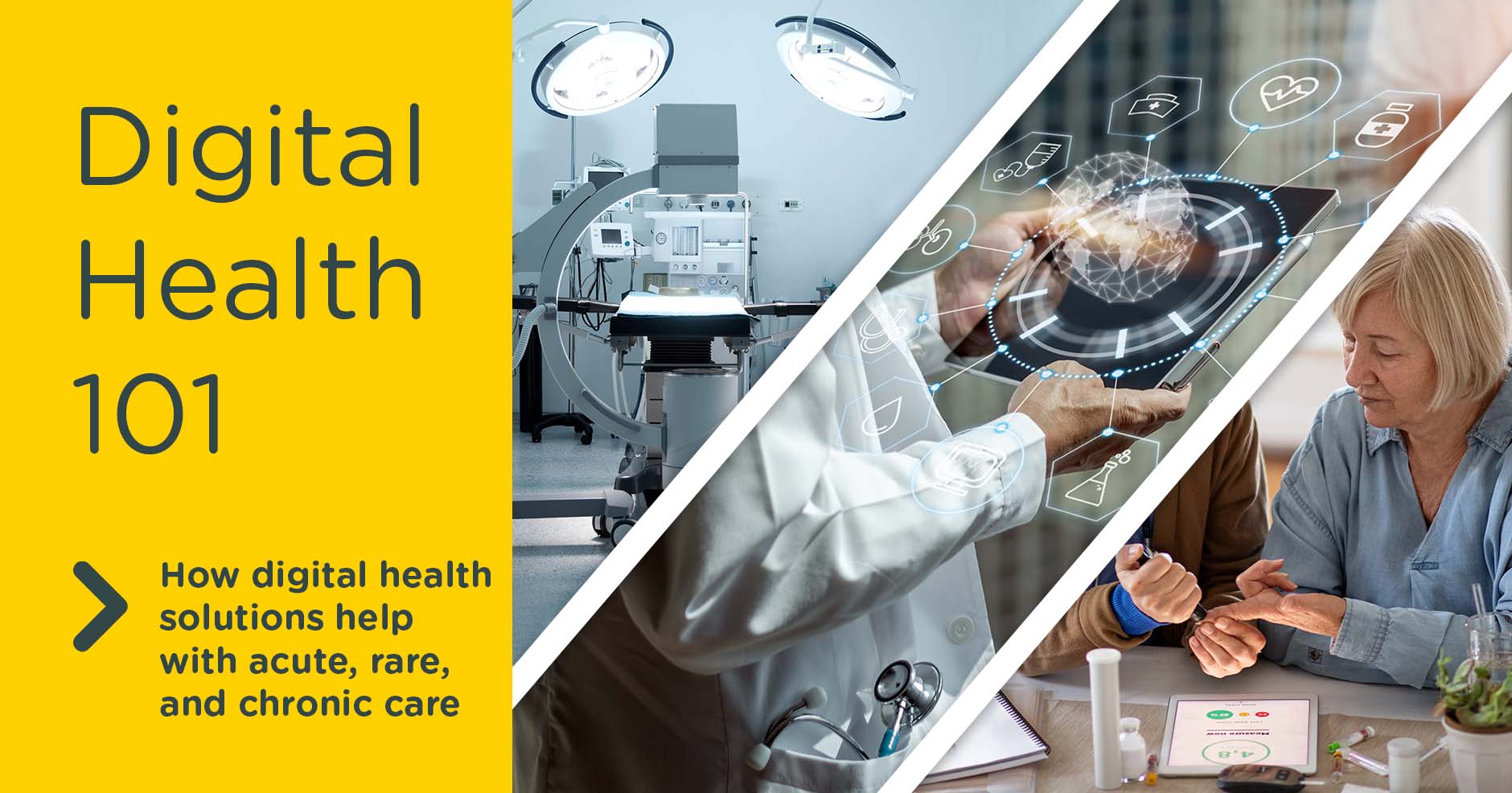In our last Digital Health 101 article we looked at some of the different types of digital health solutions pharma can create. This week we look at how digital health solutions can be used in chronic, acute, specialty, and rare diseases.
Some of the benefits of a digital approach to healthcare can be widely beneficial for pharma and patients, such as getting drugs to market more efficiently through decentralized trials. By conducting trials wherever a patient is – rather than at traditional centers of excellence – pharma companies can gain access to a greater audience, and a far greater pool of data.
Another benefit of the digital approach in clinical trials is the ability to collect richer patient-reported outcomes data than what is possible with traditional PRO endpoints. This allows us to better evaluate the real value of a drug for patients. According to DiMe (the Digital Medicine Society), 96 sponsors of medical studies have incorporated digital endpoints within their trial design.
But how can digital health solutions help in specific areas of healthcare?
Digital solutions can offset many of the challenges in rare disease
Detecting and treating a rare disease brings unique challenges. Medical expertise and specialized services are often dispersed and concentrated in urban centers, meaning patients must travel longer distances and can have larger gaps between visits. As a result, medical professionals have difficulty maintaining up-to-date information on patient status and gathering data between clinical visits.
While practical limitations like distance to treatment centers cannot be avoided, digital health solutions can be tailored to address many of the challenges arising as a result.
Capturing data through a digital solution is more reliable than traditional 'face-to-face' assessments; it can unearth valuable insights that lead to better patient care and ultimately improved outcomes.
Data gathered through a digital solution can also support individual patient reauthorization and demonstrate therapy effectiveness for increased market access, lowering the chance of disruption to successful therapy for individual patients and helping more patients.
Even simple digitization of condition management and disease information enables greater access to care and sharing of specialist knowledge.
We developed TrackSMA to facilitate capture of validated clinical assessments for spinal muscular atrophy (SMA). It enables clinical teams to record and visualize patient progress and disease progression, drives better insights on patient management, supports more informed care decisions, supports access and reimbursement.
Longitudinal disease data has proven beneficial for research purposes and growing understanding of disease history and progression over time.
Digital health solutions enable more holistic specialty and chronic care
One third of Europeans are now affected by chronic non-communicable diseases, which account for 86% of deaths in the WHO European region. Healthcare must move away from treating ailments as they arise, and shift to more proactive, predictive, and preventative care models. Digital health solutions created by pharma and life sciences companies will be crucial in bringing this change and ultimately improving patient outcomes.
Improving patient outcomes and linking patients and clinicians
Digital health tools can significantly improve patient outcomes, either as standalone solutions and digital therapeutics (DTx) or as part of an integrated approach to care to include their medication and a digital support solution. Combination products where digital apps, medication, and connected medical devices work together are particularly prevalent in widespread chronic conditions such as asthma and diabetes.
Digital companions and other evidence-based digital intervention strategies provide a closer link between patients and clinicians, making it easier to ensure patients stick to a treatment plan; especially where there are complex treatment regimes, as is often the case with specialty drugs. In essence, they give healthcare professionals the ability to observe patient behavior and monitor real-world data, allowing for earlier intervention when a particular patient’s adherence or status isn’t as expected. As a result, improved communication and adherence allows HCPs to achieve the best outcomes for their patients, and pharma businesses to fully realize the efficacy of a medication in a real-world setting.
More holistic patient care
Drugs are often just one element of a wider patient treatment program that increasingly involves digital health tools to improve outcomes.
Psoriasis is a good example: pharmaceuticals have long been administered to reduce the immune response triggered by the condition, as well as alleviate discomfort. DTx, however, can address the comorbidities that often accompany the condition – like depression and other mental health issues – and ensure a more successful overall treatment of the condition.
Measuring new outcomes enables us to articulate the immediate clinical benefits a drug can bring and factor the wider socioeconomic benefits, which are important to patients and ultimately improve their quality of life.
If we take our psoriasis example again, rather than clinicians and pharmaceutical companies judging successful treatment just on the improvement of skin-related symptoms, they can consider the overall impact on the patient’s quality of life.
Digital health solutions help reduce acute episodes and optimize acute care
Many of the acute conditions our health systems deal with have historically been caused by poorly managed – or sometimes unidentified – chronic conditions. Digital tools can directly contribute to preventing acute episodes by identifying flare triggers and nonadherence quickly and accurately, and then getting patients the care they need before a situation worsens.
So, the benefits listed above for chronic care have a knock-on effect of reducing acute episodes among those with chronic conditions, improving quality of life but also reducing the burden on resources in acute care settings.
Of course, not all health issues can be prevented, and there will always be a need for acute medical care. But digital health solutions can bring direct benefits to acute care settings beyond prevention.
Solutions designed to help clinicians track surgical site infection post-operation, for example, allow doctors to respond rapidly to an infection in its early stages and prevent further spread. While Connected drug delivery devices can optimize not just the device performance but the medication supply chain, ensuring life-saving drugs are always on hand when needed.
Digital health solutions are also uniquely placed to respond rapidly in times of crisis. At the start of the recent pandemic, the teams at S3 Connected Health developed a web-based clinical support tool for respiratory care of COVID-19. The solution enabled hospitals to optimize and scale acute respiratory care during a time of unprecedented strain on resources and was launched in record time.
This article gives just a sample of how digital health is transforming and improving acute, rare, specialty, and chronic care at present. With the right cooperation and support among life sciences companies, healthcare professionals, providers, and payers, much more is possible.
Next week, in our Digital Health 101 series, we'll look at adoption of digital health solutions.
Keep up to date with our latest blogs by subscribing to our newsletter below:


